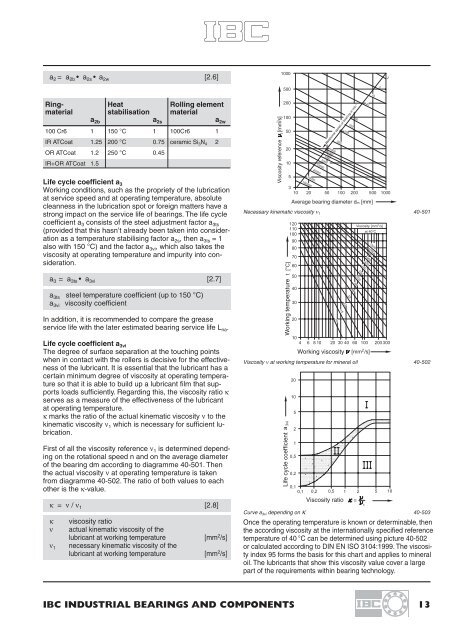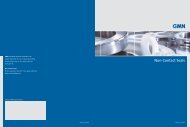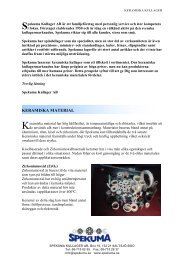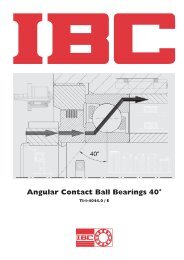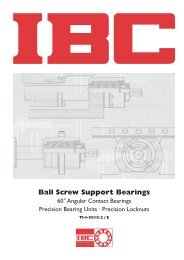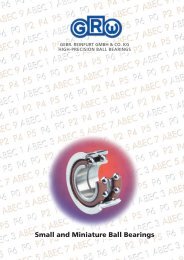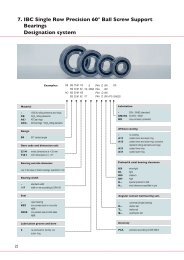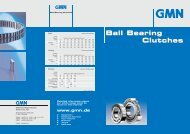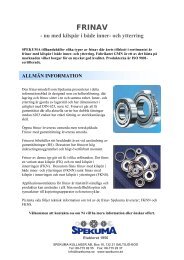IBC Cylindrical Roller Bearings - Spekuma Kullager AB
IBC Cylindrical Roller Bearings - Spekuma Kullager AB
IBC Cylindrical Roller Bearings - Spekuma Kullager AB
You also want an ePaper? Increase the reach of your titles
YUMPU automatically turns print PDFs into web optimized ePapers that Google loves.
a 2 = a 2b • a 2s • a 2w [2.6]<br />
Ring- Heat Rolling element<br />
material stabilisation material<br />
a 2b a 2s a 2w<br />
100 Cr6 1 150 °C 1 100Cr6 1<br />
IR ATCoat 1.25 200 °C 0.75 ceramic Si 3 N 4 2<br />
OR ATCoat 1.2 250 °C 0.45<br />
IR+OR ATCoat 1.5<br />
Life cycle coefficient a 3<br />
Working conditions, such as the propriety of the lubrication<br />
at service speed and at operating temperature, absolute<br />
cleanness in the lubrication spot or foreign matters have a<br />
strong impact on the service life of bearings. The life cycle<br />
coefficient a 3 consists of the steel adjustment factor a 3ts<br />
(provided that this hasn’t already been taken into consideration<br />
as a temperature stabilising factor a 2s , then a 3ts = 1<br />
also with 150 °C) and the factor a 3vi , which also takes the<br />
viscosity at operating temperature and impurity into consideration.<br />
a 3 = a 3ts • a 3vi [2.7]<br />
a 3ts<br />
a 3vi<br />
steel temperature coefficient (up to 150 °C)<br />
viscosity coefficient<br />
In addition, it is recommended to compare the grease<br />
service life with the later estimated bearing service life L na .<br />
Life cycle coefficient a 3vi<br />
The degree of surface separation at the touching points<br />
when in contact with the rollers is decisive for the effectiveness<br />
of the lubricant. It is essential that the lubricant has a<br />
certain minimum degree of viscosity at operating temperature<br />
so that it is able to build up a lubricant film that supports<br />
loads sufficiently. Regarding this, the viscosity ratio κ<br />
serves as a measure of the effectiveness of the lubricant<br />
at operating temperature.<br />
κ marks the ratio of the actual kinematic viscosity ν to the<br />
kinematic viscosity ν 1 which is necessary for sufficient lubrication.<br />
First of all the viscosity reference ν 1 is determined depending<br />
on the rotational speed n and on the average diameter<br />
of the bearing dm according to diagramme 40-501. Then<br />
the actual viscosity ν at operating temperature is taken<br />
from diagramme 40-502. The ratio of both values to each<br />
other is the κ-value.<br />
κ = ν / ν 1 [2.8]<br />
κ<br />
ν<br />
ν 1<br />
viscosity ratio<br />
actual kinematic viscosity of the<br />
lubricant at working temperature<br />
necessary kinematic viscosity of the<br />
lubricant at working temperature<br />
[mm 2 /s]<br />
[mm 2 /s]<br />
Viscosity reference<br />
Average bearing diameter d m [mm]<br />
Necessary kinematic viscosity ν 1 40-501<br />
Working temperature<br />
Working viscosity<br />
Viscosity ν at working temperature for mineral oil 40-502<br />
Life cycle coefficient<br />
Viscosity ratio<br />
Viscosity<br />
at<br />
Curve a 3vi depending on κ 40-503<br />
Once the operating temperature is known or determinable, then<br />
the according viscosity at the internationally specified reference<br />
temperature of 40 °C can be determined using picture 40-502<br />
or calculated according to DIN EN ISO 3104:1999. The viscosity<br />
index 95 forms the basis for this chart and applies to mineral<br />
oil. The lubricants that show this viscosity value cover a large<br />
part of the requirements within bearing technology.<br />
<strong>IBC</strong> INDUSTRIAL BEARINGS AND COMPONENTS 13


